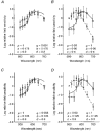Field sensitivity action spectra of cone photoreceptors in the turtle retina
- PMID: 9706024
- PMCID: PMC2231133
- DOI: 10.1111/j.1469-7793.1998.479bh.x
Field sensitivity action spectra of cone photoreceptors in the turtle retina
Abstract
1. The Stiles two-colour increment threshold technique was applied to turtle cone photoreceptors in order to derive their field sensitivity action spectra. 2. Photoresponses of cone photoreceptors were recorded intracellularly. Flash sensitivities were calculated from small amplitude (< 1 mV) responses. The desensitizing effects of backgrounds of different wavelengths were measured and the background irradiance needed to desensitize the cone by a factor of 10 (1 log unit) was defined as threshold. The reciprocals of these thresholds were used to construct the field sensitivity action spectrum. 3. The field sensitivity action spectra of long-wavelength-sensitive (L) and medium-wavelength-sensitive (M) cones depended upon the wavelength of the test flash used to measure them. This excludes the possibility that turtle cones can function as single-colour mechanisms in the Stiles sense. 4. In fourteen L-cones, the average wavelength of peak sensitivity of the field sensitivity action spectrum was 613.7 +/- 7.7 nm for the 500 nm test and 635.6 +/- 9.6 nm for the 700 nm test. For six M-cones, these values were 558.5 +/- 6.8 and 628.8 +/- 10.6 nm for the 500 and 700 nm tests, respectively. 5. Two physiological mechanisms are suggested as contributing to the dependency of the field sensitivity action spectrum upon test wavelength. One is based upon the transmissivity properties of the coloured oil droplets, while the other hypothesizes excitatory interactions between cones of different spectral type. 6. Computer simulations of the field sensitivity action spectra indicate that both mechanisms are needed in order to account for the dependency of the field sensitivity action spectrum upon the wavelength of the test flash.
Figures











Similar articles
-
The action spectra of cone photoreceptors in the turtle (Mauremys caspica) retina.Vis Neurosci. 1994 Mar-Apr;11(2):243-52. doi: 10.1017/s0952523800001607. Vis Neurosci. 1994. PMID: 8003451
-
Spectral properties of short-wavelength (blue) cones in the turtle retina.Vis Neurosci. 1992 Sep-Oct;9(3-4):235-41. doi: 10.1017/s0952523800010646. Vis Neurosci. 1992. PMID: 1390383
-
Detection and resolution of visual stimuli by turtle photoreceptors.J Physiol. 1973 Oct;234(1):163-98. doi: 10.1113/jphysiol.1973.sp010340. J Physiol. 1973. PMID: 4766219 Free PMC article.
-
S cones: Evolution, retinal distribution, development, and spectral sensitivity.Vis Neurosci. 2014 Mar;31(2):115-38. doi: 10.1017/S0952523813000242. Epub 2013 Jul 29. Vis Neurosci. 2014. PMID: 23895771 Review.
-
[Effects of light on reproductive processes in fungi; hypotheses on the identity of photoreceptors. A bibliographic revue].Mycopathologia. 1976 Dec 10;60(1):3-16. doi: 10.1007/BF00442542. Mycopathologia. 1976. PMID: 796727 Review. French.
Cited by
-
Which way is up? Asymmetric spectral input along the dorsal-ventral axis influences postural responses in an amphibious annelid.J Comp Physiol A Neuroethol Sens Neural Behav Physiol. 2014 Nov;200(11):923-38. doi: 10.1007/s00359-014-0935-x. Epub 2014 Aug 26. J Comp Physiol A Neuroethol Sens Neural Behav Physiol. 2014. PMID: 25152938
References
-
- Baylor DA. Lateral interaction between vertebrate photoreceptors. Federation Proceedings. 1974;33:1074–1077. - PubMed
Publication types
MeSH terms
Grants and funding
LinkOut - more resources
Full Text Sources

